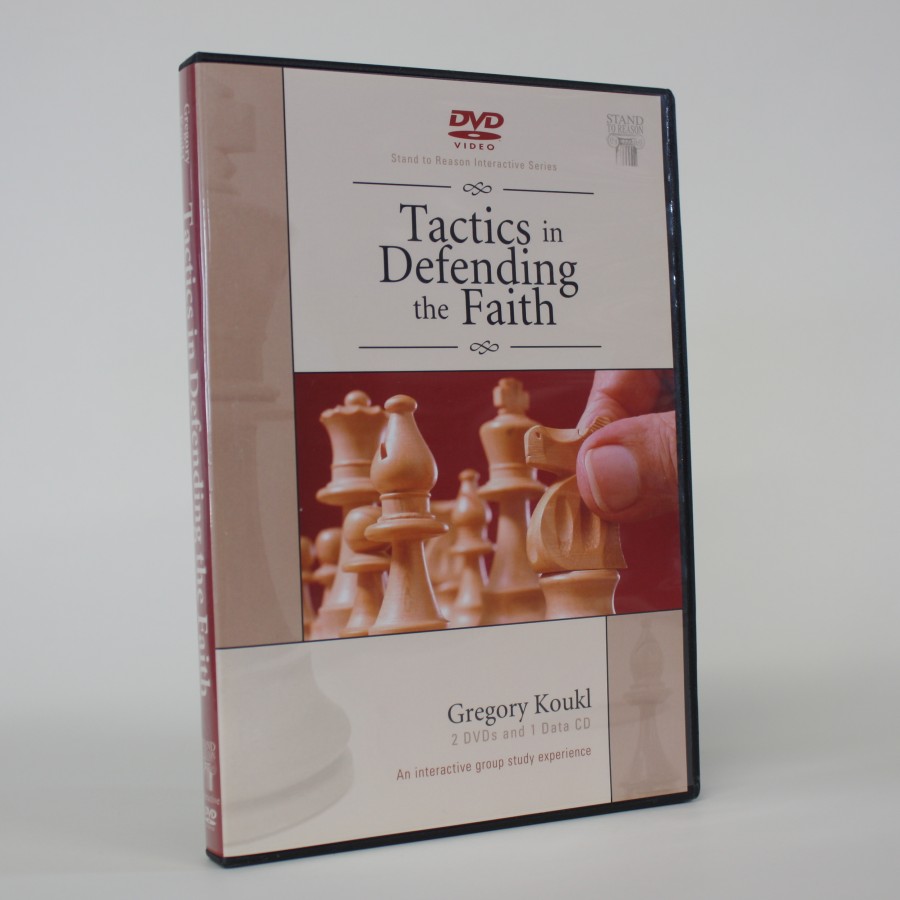For six weeks starting on February 3rd at Calvary Chapel Des Moines, I facilitated a class of nine people using the DVD, Tactics in Defending the Faith; a video-based course taught by Stand to Reason’s founder — Greg Koukl. Though the video series was originally created in 2006, its teaching is timeless and much needed today to battle the forces of evil on a spiritual and intellectual level.
On the back of the DVD jacket, it says about itself:
“Tired of finding yourself flat-footed and intimidated in conversations about your faith and values? Want to increase your confidence and skill in discussions, no matter whom you’re talking to?”
Tactics in Defending the Faith
It did not disappoint. Immediately, the group was engaged and realized the value of this free course they were a part of. They learned how to initiate conversations effortlessly; stop challengers in their tracts; graciously and effortlessly expose faulty thinking; maneuver through intellectual minefields; and present the truth clearly, cleverly, and persuasively. Even though each class was set up to be one hour long, the conversations that took place within our group more than doubled our time together. It was great to see them understand that this course was designed to help those who even if they have limited knowledge of what a person believes, they can still engage them in the truth and even better — get the other person to think through their claims and see the errors within.

The Classes
Each class was designed to take you from the uninformed evangelist to actually pointing out faulty claims and beliefs of those we are conversing with. They are not tricks, ruses, or used to belittle the unbeliever, but to get us to a mutual understanding as quickly and effectively as possible.
Session 1: Getting You in the Driver’s Seat — Learning the Columbo Tactic
The Columbo Tactic is named after the Columbo character from the television show that bore his name. He was the overlooked detective always asking questions, wearing an overcoat and smoking a cigar. He carried a pad of paper, but always misplaced his pen. He seemed inept, but in reality, was a genius at figuring out who perpetrated the crimes, all the while gathering information with every question he asked.
The same is true with the Columbo Tactic. This tactic is designed to get you out of the hotseat and gain information. When you hit a roadblock, ask a question. One of my 10 Commandments of Evangelism is –to never make a statement where a question would suffice. Asking questions are advantageous for a number of reasons:
- Questions are interactive, inviting others to participate.
- Questions make headway without requiring you to state your case, or even know anything.
- Questions shift the burden of proof to the other person, because the person who makes the claim bears the burden. With questions, there is no claim, only gathering information.
- Questions puts you in the driver’s seat of the conversation. You can steer it anywhere you want just using questions.
- Questions are a casual conversation starter.
- Questions can buy you time to formulate your response in the conversation.
- Questions give you information for this and future encounters.
We also learned the first of the two Columbo Questions: “What do you mean by that?” And other forms of that question. This is invaluable because it immediately engages a non-believer in an interactive way and flatters them because it shows interest in his or her view. But it also forces the non-believer to think more carefully about what they believe.
Session 2: Refining the Columbo Tactic
This next session took us from knowing what the unbeliever believes, to why they believe what they believe by using the question, “How did you come to that conclusion?” Or other variations like it. When a person makes a statement, we assume the non-believer has actually reached a conclusion and that he has reasons why he believes it. Because the person who makes the claim bears the burden of defending it, all the pressure is on the unbeliever, not us. Asking them to defend their argument is very important, and from what I experienced in the past, many people have never thought about the things they believe.
We also learned that it is not our job to refute their claims either. We can point out their faults, but it is not our job to do the grunt work to find out if their claims are true. By using these two questions, “What do you mean by that,” and “How did you come to that conclusion,” you can take charge in any conversation without knowing anything.
Session 3: Perfecting the Columbo Tactic
Through the two opening questions we learn a few things about what the non-believer actually believes. At this point, there are some things we need to know, and what to look out for to exploit a weakness of flaw in their beliefs. Do the conclusions of what the person believes follow the evidence? With practice when the pressure is off, we can get better at this over time.
Session 4: The Suicide Tactic
Sometimes what people say and the reasons for what they believe self-destruct as the person is explaining their views. These statements commit suicide and have within themselves the seeds of their own destruction. Statements like:
- “I cannot speak a word in English,” is self-refuting when spoken in English.
- “There are no sentences more than five works in length.” This sentence is more than five words in length (and so is that one).
- “You can’t know anything for sure.” Are you sure about that?
This exploits the law of non-contradiction: that two contradictory statements cannot be true at the same time. Does the basic premise, conviction, or claim undermine itself? If it does, you can use the Suicide Tactic as a preemptive strike against them.
Session 5: The “Taking the Roof Off” Tactic
This tactic was first developed by the late Francis Shaeffer:
“We confront men with reality; we remove their protection and their escapes, and we allow the avalanches to fall.”
Francis Shaeffer
This is by far my favorite tactic to use when pointing out the flaws of a person’s argument. It is done by first adopting a person’s viewpoint for the sake of argument, and then pressing it to the most logical and absurd consequence of his view. When we reduce their point of view to its most common denominator, we give it a “test drive” and see where it goes. What will the result be if we follow the same logic as our friend believes? As we invite the person to consider the implications of their view, does it make sense or is it logical?
Most of the time when I do this, like I did with the man stating I only had my interpretations, I try to use a parable or story like Jesus did.
Session 6: The “Steamroller” Tactic
Of all the tactics, this one is the only defensive tactic. Have you ever spoken with a person that just cut you off in the conversation or asked question after question without listening to the answers? This is the Steamroller: people who overpower you with their strong opinions and their big attitudes. Steamrollers know it is easier to ask hard questions than it is to listen to hard answers. They are not interested in the answers, but in winning. This tactic helped us move through that.
We learned that there are three steps in stopping a steamroller. First, we stop the advance and negotiate an agreement. If that doesn’t work, shame the person by firmly but kindly reminding them of their rudeness, and of your agreement. When all else fails, it is best to let them have the last word and walk away. Why waste your breath on their deaf-ear. With each attempt we ask for an agreement and wait for a response. It is important to get an agreement, because if you don’t the Steamroller will not stop rolling you over.
The most used tactics
All of these tactics have their place in evangelism, and I use them more than any other in conversation on the street and especially at the Creation Booth of the Iowa State Fair. They are invaluable in starting meaningful conversations and giving God the glory being “wise as serpents and harmless as doves.” (Matthew 10:16)
I would love to teach another seminar on this valuable topic, and I am also interested in doing this in a video chat forum as well for my friends who don’t live in the Des Moines area or in other states. If you are interested, let me know. God bless.
Sign up for content like this delievered directly to your E-mail inbox.


Wow, Frank, that sounds wonderful! Would you consider holding an online class like we did with Tony?
LikeLiked by 1 person
I would be interested. Maybe after the summer.
LikeLike
Count me in!!!
LikeLiked by 1 person